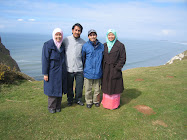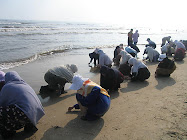Friday 2 November 2012
Wednesday 20 June 2012
Islamic Parenting-Pendidikan Anak Memgikut Method Nabi
.jpg)
Kupasan:-
Membahas secara lengkap aspek pendidikan anak ala Nabi yang telah terbukti mampu melahirkan generasi terbaik.Mulai saat anak masih berada dalam sulbi ayahnya hingga dilahirkan, tumbuh menjadi besar mencapai usia baligh dan menjadi seorang dewasa.
Saturday 14 January 2012
FEVER BABIES & TODDLER
Fever
Your child awakens in the middle of the night crying inconsolably. She feels hot to the touch, and you quickly take her temperature. 103 degrees! (39.5 Celcius) You are understandably worried! Should you call your doctor? Should you rush her to the emergency room?
RELAX. DON'T PANIC!
Here are some helpful tips about fevers that will get you safely and comfortably through the night.
- Remember, fevers are your body's natural response to infection, and not necessarily a sign that something serious is taking place.
- Low-grade fevers are generally not serious, are easily treated, and can wait until the morning to be evaluated by your doctor.
- Fevers of 101 to 103 (38.4 to 39.5 Celcius) are also generally not serious and can wait until morning to be evaluated, except as indicated below.
- High fevers of 104 (40 Celcius) or higher that quickly come down to 100 or 101 (37.8 to 38.3 Celcius) with the treatment measures below are also generally not serious and can wait until morning, except as indicated below.
So for now, don’t rush to page your doctor. Read through this section, and call your doctor during office hours, or page your doctor according to the following guidelines:
Here are the situations that usually warrant an urgent call to your doctor. If none of these fit your current situation, then you probably don’t need to page your doctor. Follow our treatment advice below and call your doctor during office hours.
- If your infant is 6 weeks or younger, and has a fever of 101 or higher, this is considered a medical emergency. Your doctor should evaluate your infant right away, either during business hours, or in an emergency room after hours. Do not give any fever-reducing medications in this situation (you don't want to hide the fever until after a doctor has evaluated your baby). Be sure to confirm any fevers with a rectal thermometer (if available) before contacting your doctor.
- Infants age 7 weeks to three months with a fever over 101 warrant an appointment with your doctor within the next several hours. You generally don’t need to page your doctor in the middle of the night in this situation if the office opens within the next few hours. Simply follow our recommendations on treating fever below and call your doctor in the morning. If it is the early evening you should probably page your doctor, since the office won’t be open until the following day. Be sure to confirm any fevers with a rectal thermometer (if available) before contacting your doctor.
- If your child of any age has one or more of the following symptoms, you should probably call your doctor right away:
- High fevers of 104 (40 Celcius) or higher that don't come down to 101 or 102 (38.3 to 38.9 Celcius) with the treatment measures below.
- Lethargy – this means more than your child just isn't acting right or laying quietly in your arms. Lethargy actually refers to your child being limp, lifeless, unresponsive, or won't make eye contact.
- Irritability - this means more than just fussiness. A truly irritable child will cry for hours with minimal verbal interaction, and is almost impossible to console.
- Meningitis – symptoms are high fever, stiff neck or pain in the back of the neck, vomiting, headache, bright light hurts the eyes. Before paging your doctor, you should also look up any other symptoms your child has, such as cough, vomiting, rash, etc and read those guidelines to determine your best course of action.
No. Many parents have a misconception that fevers are a bad thing and a sign that there is some serious underlying illness. This simply is not true. Fever is a normal and healthy response of the body to an illness. The body's immune system releases chemicals that raise the body temperature. This is part of the normal infection-fighting process.
- Normal temperature – 97 to 99 degrees (36 to 37.2 Celcius).
- Low-grade fever – 99 to 100.9 degrees (37.3 to 38.3 Celcius).
- Common fever – 101 to 103.5 degrees (38.4 to 39.7 Celcius).
- High fever – any fever over 103.6 degrees (39.8 Celcius).
No. Low-grade fevers are helpful in fighting off infection. You should only treat a fever when it is making your child miserable. Treat your child, not the fever.
- Viral infection – this is the most common cause of fever in children. Examples are: Roseola, Colds, Flu, Coxsackie (hand, foot and mouth disease), Chicken Pox, Fifth Disease, and many others. Most viruses are not dangerous. They simply need to run their course over several days. They are not treatable with antibiotics.
- Bacterial infection – Some examples include ear infection, sinus infection, pneumonia, bladder infection, and strep throat. These are treatable with antibiotics, although treatment can usually wait 12 hours until you can contact you doctor in the morning.
- Teething– this can cause fevers, though usually not higher than 101.
- Regular glass underarm thermometer– this seemingly "old fashioned" method is still probably the most accurate, although difficult to do with a crying, squirming child. Try to hold in place for 3 minutes, making sure the tip is deep in the soft underarm skin.
- Ear thermometer – this quick and easy method has become more popular. The accuracy of these thermometers varies, however. One ear may read 98, the other 103. Which do you believe? If it reads close to normal, then it's probably true. If it reads 103 (39.5 Celcius) or greater, you may want to confirm this with a glass under thermometer! Readings between 99 and 102 (37.2 to 38.9 Celcius) are more reliable.
- Rectal glass thermometer – this method should only be used for newborns through age 3 months since accuracy is crucial for this age. Gently insert the thermometer approximately ½ inch into the anus and hold in place for 3 minutes.
- Digital thermometer – these are oral, underarm or rectal. They are much faster than a glass thermometer, although you do lose some accuracy as with the ear thermometer.
- First step – decide if the fever warrants treatment as discussed above.
- Medications
- Acetaminophen– this fever reducer/pain reliever has been around a long time and is effective is most cases. It can be given every 4 hours. Click on it for dosing chart.
- New research in 2001 has shown that giving an initial double dose of acetaminophen for high fevers is both safe and more effective to bring down that high fever fast. Only give a double dose if the fever is high. You can only give a double dose once every few days if needed. Any other doses should be the regular dose.
- Ibuprofen– this newer medication is also effective for fever and pain. It often works better for higher fevers, and lasts longer too. It can be given every 6 hours. It was previously only approved for children 6 months and older. Recently it was approved safe and effective for infants down to two months of age. Click on it for dosing chart.
- Using both medications – it is best to only use one of these two medications. However, if one by itself isn't enough or wears off too soon, then it is safe to give the other medication on top of the first without waiting. Another option is to alternate between them every 3 hours. Give acetaminophen at 8:00, ibuprofen at 11:00, acetaminophen at 2:00 and so on.
- WARNING – don't give ASPIRIN to children 12 and under.
- Vomiting - if your child is vomiting and won't keep down any medication, you can use acetaminophen suppositories available over the counter. Click here for the acetaminophen dosing chart.
- Lukewarm bath and cool washcloth – this can help get a fever down fast, especially if it is high, but only use along with, not instead of fever lowing medication.
- Cool liquids to drink can help cool down a fever and keep your child well hydrated.
- Remember, fevers are your body's natural response to infection, and not necessarily a sign that something serious is taking place.
- Low-grade fevers are generally not serious, are easily treated, and can wait until the morning to be evaluated by your doctor.
- Fevers of 101 to 103 (38.4 to 39.5 Celcius) are also generally not serious and can wait until morning to be evaluated, except as indicated below.
- High fevers of 104 (40 Celcius) or higher that quickly come down to 100 or 101 (37.8 to 38.3 Celcius) with the above measures are also generally not serious and can wait until morning, except as indicated below.
ABOVE ALL, IF YOU HAVE A "GUT FEELING" THAT YOUR CHILD IS SERIOUSLY ILL; YOU SHOULD CONTACT YOUR DOCTOR RIGHT AWAY.
http://www.askdrsears.com/topics/childhood-illnesses/fever



























 Kuala Lumpur Time
Kuala Lumpur Time


